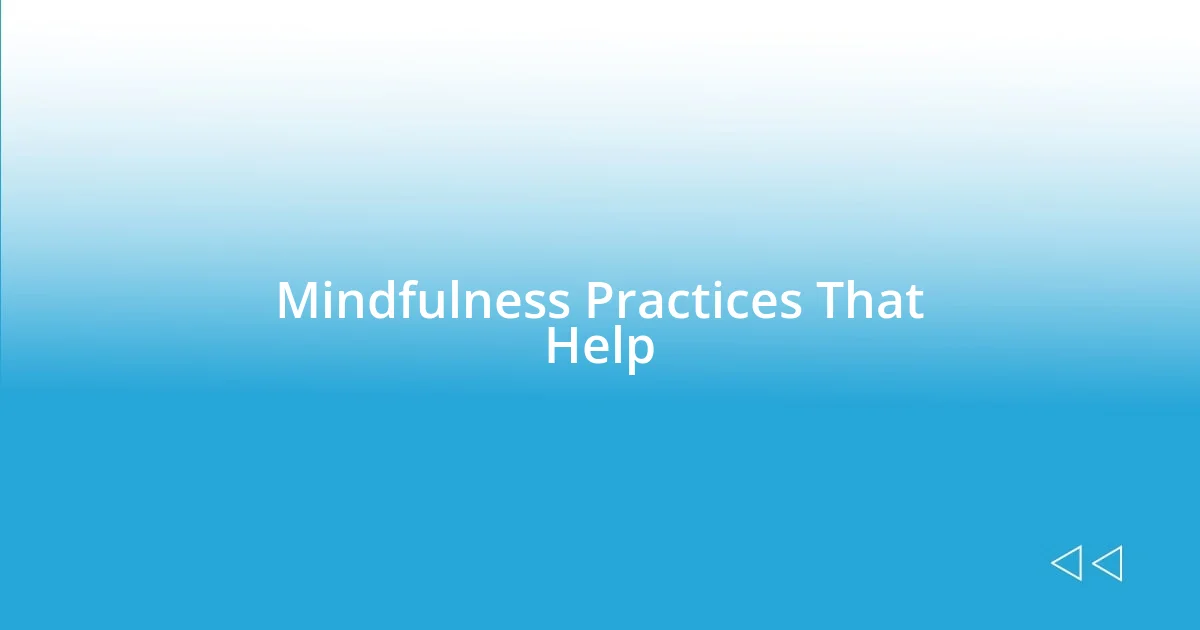Key takeaways:
- Anxiety often manifests unexpectedly in everyday situations, making it vital to recognize personal triggers and coping strategies.
- Practices like mindfulness, gratitude journaling, and physical activities such as yoga and dance can significantly reduce anxiety and promote calmness.
- It’s essential to seek professional help when anxiety interferes with daily life or leads to persistent physical symptoms and overwhelming thoughts.

Understanding Anxiety in Everyday Life
Anxiety can creep into the most ordinary moments of life, often when we least expect it. I remember walking into a coffee shop and suddenly feeling overwhelmed by the chatter around me. Why does something as simple as ordering a drink make my heart race? It’s in these everyday situations that anxiety can manifest, reminding us how sensitive we can be to our environment.
Living with anxiety often feels like carrying an invisible weight. I have days when the thought of meeting friends feels daunting; what if my mind goes blank or I say something awkward? Those thoughts can be paralyzing, yet it’s important to recognize that many people experience similar struggles. Isn’t it comforting to know that you’re not alone in your feelings?
Understanding anxiety also means becoming aware of its triggers in our daily lives. For instance, I’ve noticed that my anxiety spikes in crowded places or during long stretches without downtime. Feeling overwhelmed can be a signal for me to step back and recalibrate. How do you handle those moments when life gets chaotic? It’s a crucial question, as recognizing our patterns can lead us toward more effective coping strategies.

Practical Techniques for Reducing Anxiety
Practicing mindfulness has become one of my go-to techniques for reducing anxiety. There have been mornings when I wake up feeling a tightness in my chest, but taking just ten minutes to breathe deeply and focus on the present helps me regain my composure. It’s amazing how shifting my awareness to my breath can transform my anxiety into a sense of calm. Have you ever tried observing your surroundings without judgment? It can feel like stepping back into the driver’s seat of your mind.
Another effective strategy I’ve found is keeping a gratitude journal. On days when anxiety feels more pronounced, I make it a point to jot down three things I’m grateful for, no matter how small. I remember a particularly stressful week where listing even simple things—like a bird chirping outside my window or a friend’s supportive message—worked wonders. How does this shift in perspective resonate with your experience? It’s remarkable how focusing on positives can slowly drown out those nagging anxious thoughts.
Physical activity also plays a significant role in my anxiety management. Whether I go for a brisk walk or dance around my living room, moving my body releases pent-up energy and tension. I find it particularly liberating when I allow myself to let go and just enjoy the movement. Have you ever noticed how a bit of exercise can lift your mood almost instantly? The connection between physical exertion and mental clarity has proven invaluable for my peace of mind.
| Technique | Description |
|---|---|
| Mindfulness | Breathing deeply and focusing on the present moment to regain calm. |
| Gratitude Journal | Writing down things you’re grateful for to shift perspective away from anxiety. |
| Physical Activity | Engaging in exercise to release energy and boost mood. |

Mindfulness Practices That Help
Mindfulness practices have truly been a game changer in my journey to manage anxiety. One technique that I consistently return to is the simple act of mindful breathing. During moments of heightened anxiety, like when I find myself caught in a spiral of overwhelming thoughts, I take a pause to focus on my breath. I inhale deeply for a count of four, hold for four, and exhale for six. This rhythmic pattern anchors me, often reminding me that in this moment, I am safe. It’s remarkable how a few minutes of deliberate breathing can create a pocket of calm, allowing me to reflect rather than react.
In addition to mindful breathing, I’ve come to appreciate the practice of mindful observation. I recall a rainy afternoon when I sat by my window, watching the droplets trickle down the glass. Instead of letting my mind race with worries, I focused on the sounds of the rain and the patterns it created. This exercise not only distracted me from anxiety but also grounded me in the present. Here are some mindfulness tools that I find particularly effective:
- Mindful Breathing: Focusing on your breath can create an instant sense of relief and calmness.
- Body Scan Meditation: I often lie down and mentally note the sensations in various parts of my body, releasing tension as I go.
- Guided Imagery: Listening to calming audio that takes you through relaxing visualizations can be a soothing escape.
- Nature Walks: I enjoy walking in nature, engaging my senses to notice colors, sounds, and scents, which naturally lifts my mood.
Incorporating these practices into my routine has not only helped reduce anxiety but also fostered a deeper connection with myself and my surroundings. I highly recommend exploring them to see what resonates with you!

Physical Activities for Anxiety Relief
Engaging in physical activities has been transformative for my anxiety management. I remember one particularly anxious day when I felt overwhelmed by a looming deadline. Instead of succumbing to stress, I decided to step outside for a quick jog around the block. That burst of movement not only cleared my head but also released a flood of endorphins—those feel-good hormones that lifted my spirits significantly. Can you recall a time when a simple walk or jog turned your mood around?
I’ve also rediscovered the joy of yoga, which uniquely blends movement with mindfulness. On days when my anxiety feels like a heavy weight, rolling out my mat and flowing through a sequence helps create a connection between my body and mind. The stretching feels like a gentle release, allowing me to expel anxious energy while fostering a sense of calm. Have you ever felt the refreshing tranquility that comes with a few deep stretches?
Dancing is another physical activity that works wonders for me. Whether I’m turning up the music in my living room or moving to the rhythm at a class, letting go through dance feels liberating. There’s something about allowing my body to move freely that cultivates joy and connection to the moment. It’s as if I’m shedding the layers of my anxiety with every beat. What about you—have you ever danced your worries away?
Incorporating these physical activities into my daily life has truly been a valuable toolkit for combating anxiety. Each movement brings me a step closer to feeling grounded and at peace within myself.

Dietary Changes That Support Calmness
Diet has a profound effect on our mental well-being, and I’ve found that making thoughtful dietary changes has played a significant role in fostering calmness. For instance, I’ve noticed a remarkable difference in my anxiety levels since I started incorporating more omega-3 fatty acids into my meals. Foods like salmon and walnuts are excellent sources, and I often whip up a simple salmon salad for lunch. Not only does it taste delightful, but I truly believe it helps soothe my racing mind.
Another powerful shift for me has been reducing caffeine intake. I used to rely on that morning coffee boost, but I noticed how jittery and anxious I felt afterward. Now, I opt for herbal teas like chamomile or peppermint, which I find calming and refreshing. There’s something comforting about sipping a warm cup, especially during a quiet evening, don’t you think?
Hydration is another aspect that I pay close attention to. I carry a water bottle with me throughout the day and make a conscious effort to stay hydrated. I’ve experienced moments when dehydration left me feeling foggy and irritable. The clarity that comes from drinking enough water is so rejuvenating; it feels like I’m washing away not just physical fatigue but mental clutter too. How do you ensure you’re getting enough water? The difference it makes in our overall mood is truly incredible!

Building a Supportive Environment
Creating a supportive environment has been crucial for my anxiety management. I remember transforming my work space by adding plants and photographs that make me smile. It’s fascinating how those small, personalized touches can turn a sterile space into a comforting sanctuary. Have you considered how your surroundings might impact your mood?
Beyond just aesthetics, surrounding myself with understanding friends and family has made a huge difference. On particularly challenging days, just the presence of a supportive friend can create a sense of safety that alleviates anxiety’s grip. I often find myself reaching out, whether it’s a text or a coffee date, and that connection helps ground me. Have you ever noticed how conversation can lift your spirits?
Additionally, I’ve learned the importance of setting boundaries in my relationships. It’s okay to say no to situations that feel overwhelming. When I protect my energy, I create a space where I can breathe and be myself. I remember one instance where I gracefully declined an invitation, and the relief that washed over me was profound. Do you prioritize your own mental well-being in your social interactions? Recognizing what serves you can truly empower your journey to tranquility.

When to Seek Professional Help
Recognizing when to seek professional help for anxiety can be a crucial step. I’ve found that when anxiety begins to interfere with daily life—think struggling to get out of bed or feeling overwhelmed just by simple tasks—it’s a clear signal that talking to a professional could be beneficial. Have you ever felt that weight pressing down on you, making it hard to breathe? That’s when I realized I needed assistance outside my usual coping mechanisms.
Sometimes, anxiety can spiral into physical symptoms like insomnia, panic attacks, or persistent fatigue. I recall a period when I felt constantly exhausted, not just mentally but physically as well. I’d lie awake at night, feelings circling like a carousel in my mind. It was during that time that I understood how vital it was to consult a therapist who could provide tools to manage those overwhelming feelings. Can you remember a moment when you felt like you were at your limit? Seeking help sometimes feels like the strongest choice we can make.
Another important factor is the presence of thoughts that seem beyond your control, such as constant worrying or fearful ruminations that disrupt your peace. I’ve experienced those relentless thoughts, as if my mind was stuck on repeat. It took me a while to admit that I needed someone to help me unpack that heavy baggage. If you’re finding it difficult to shake off negative thoughts that linger, maybe it’s time to consider reaching out for professional support. Wouldn’t it feel liberating to have someone guide you through that maze?
















